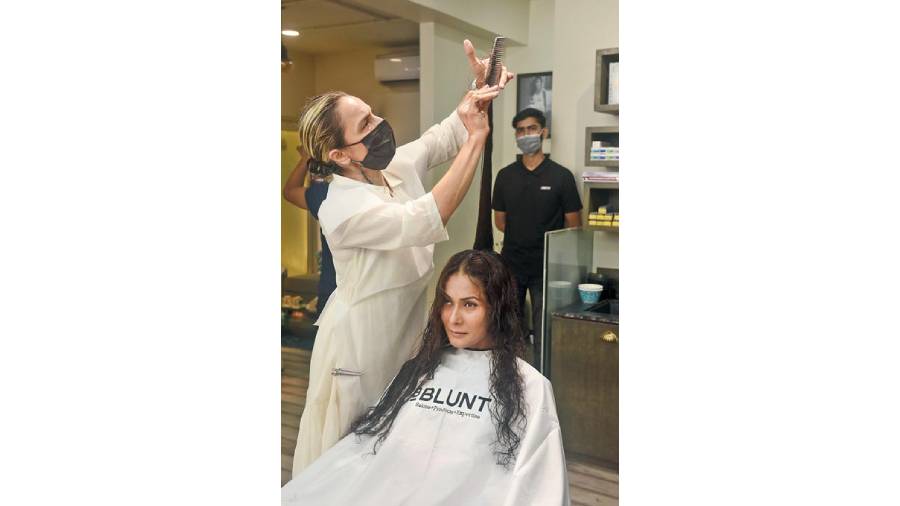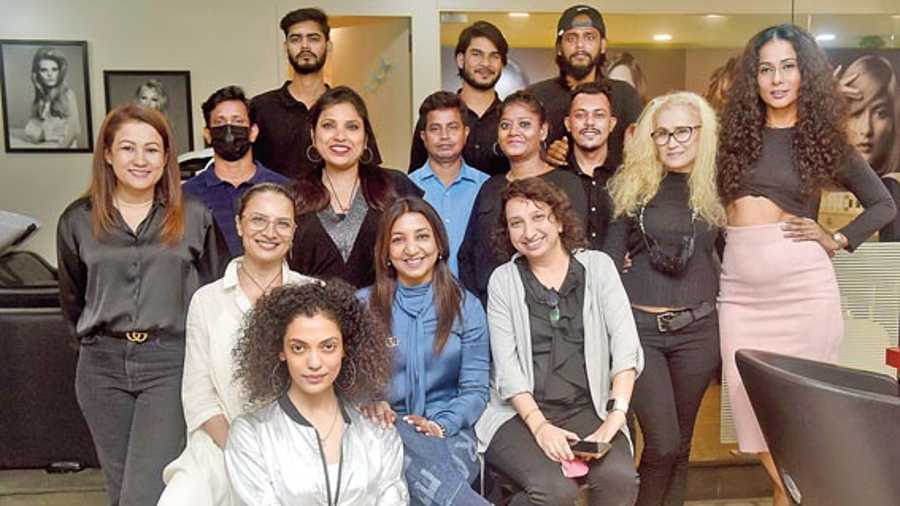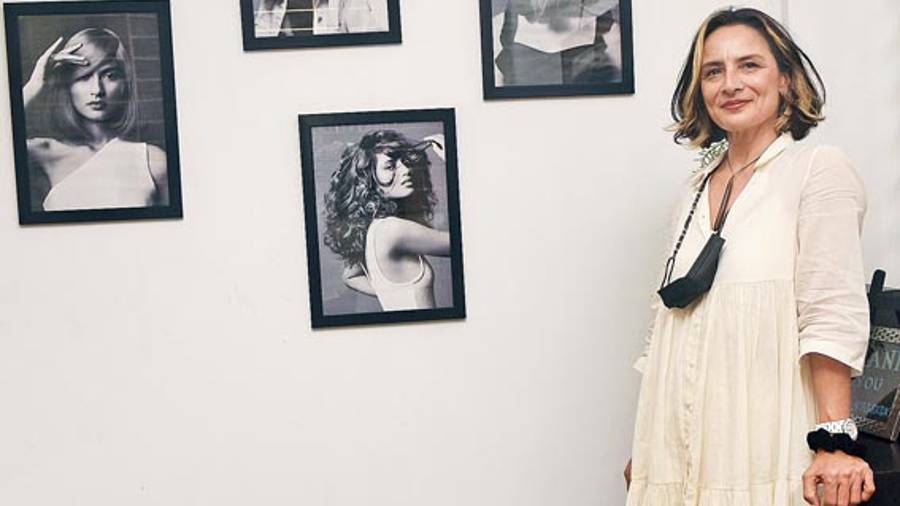Flowy off-white kurta-dress, white pants rolled up, milk white sandal sneakers, minimal jewellery, zero make-up, edgy cool hair and oodles of panache. Adhuna, the BBLUNT empress. When we walked into BBLUNT Kolkata
(35 Supra Court, Lansdowne Terrace, off Sarat Bose Road) on October 22, Adhuna was in a session with the team. This was her first visit to the Calcutta salon that also coincided with its first birthday. “I believe in cutting hair in its natural form, working with the natural fall of the hair so that when the client leaves the salon, they can manage their hair themselves at home,” Adhuna told us post-session as she settled down for a chat with t2. Candid and endearing, Adhuna looked back at her journey and told us why she didn’t like kulfi!
Tell us about your Calcutta connect...
I am half-Bengali and my father was from Calcutta and he left India to go and study and work in the UK, met my mom and the rest is history (laughs). He never wanted to come back to India. Unfortunately, my father passed away when we were quite young. We didn’t learn the language or ever really spend any time here because of his personal taste and choices. But when he passed away, my mom actually did bring us to visit.... There are lots of relatives... in Salt Lake.
But that was many years ago. I was 12 and my brother, Osh, who is my partner in the business, and my twin sister, all three of us were brought to India and we didn’t really like our experience when we first came here. We were born and brought up in the UK. Even an ice cream was different! I remember asking for an ice cream and they gave us kulfi. Of course everybody loves kulfi, but we were like ‘what is this?’ (Laughs) I have lived in India for almost 30 years now and I never have kulfi! (Laughs) I don’t really love milky kinds of sweets. My favourite is gulab jamun. Give me chocolate any day!
Over the years you have been in the city...
I have brought my children to meet my family here. In fact, my cousin is very upset with me... how could I come for two days and not see them.... I have come after a long time, a good five-seven years.
Do you see any difference?
I do. I see modernisation and all the high-end brands are here. I didn’t expect that. I feel it’s a little cleaner. I always like to take the window seat and the greenery hit me as I was flying in. Of course, it’s the outskirts, but still it was looking so beautiful.
What Bengali traits do you have?
Thinking that I know everything! (Laughs out loud) My high forehead. I always say it’s a sign of intelligence. Jokes aside, my twin sister looks like my mom’s side of the family and while I was growing up, everyone said I looked like the women on my dad’s side of the family. So my sister looks a lot more western than I do and I fit a bit more into the Indian mould.
You have made hairstyling so aspirational. How do you think today’s youngsters are approaching this profession?
It’s a really tough question to answer actually. When I first came to India, 30 years back, it was an amazing time to be in this business. It was unexplored and few recognised brands, which still exist today, like Nalini and Yasmin... I went and worked with them... they were very forward-thinking for their time. I have freelanced here for some time. Then when L’Oréal started in India, their professional division, I worked for them and got to travel the whole of the country. It was amazing to see the openness for hairdressers. They were dying to learn something new. Internet was not yet happening, but the desire for something new was apparent. Then with the Internet and the arrival of many big foreign brands in India, beauty and hairdressing has really evolved and the attitude, say for example, of a parent allowing their child to come into this profession....
It is prestigious and everyone wants to be like Adhuna...
I don’t know if it is prestigious... I think you are being kind.... So, Adhuna hasn’t created this whole story on her own. Yes, I was a passionate hairdresser and I think it was one of the main ingredients to this story of BBLUNT. Along the way, I have met many passionate hairdressers who have also come and worked alongside us and some of them have trained with us and learned from us and there is a balance. Luckily, I have a great relationship with my brother and that way I was able to do a business because my mind is creative, while his is more logistical and realistic (laughs). One of the things I have learned in the business is to always work with people who have a different skill set and can enhance your skill set. That has really helped progress our business forward.
What changed it for the Indian hairdressing industry?
A combination of things... the influx of big brands who offered education and training. Our brand was built on education and training. And, I think films have huge influence on what we were able to do. Dil Chahta Hai for us was...
A game changer?
An unintentional game changer, in the sense that when we started working on that film, Avan (Contractor) and I had never done a film before. Avan has worked in production. So, she had a little sense of film. I had a sense of fashion and we worked together to create these looks and then obviously maintaining it on the set. The whole image of the film from each and every actor who was there to how the costume was and how the sets were created, the look and feel of the light, everything in the film was new and when we approached the job, we approached it the way we were approaching hair in our salon.
We didn’t say we will create this amazing thing and it’s going to revolutionise the way hair is looked at in film. That happened because of the passion with which we approached the project.
We also had three male actors (Aamir Khan, Saif Ali Khan and Akshaye Khanna) who were open to change. The credit (for the iconic looks) goes to Avan Contractor and not to me. Avan worked on the film. She did the haircuts. I was pregnant at the time, so I couldn’t get close to the chair. There were many firsts for all of us. I think the impact that that film had did wonders for our reputation. I don’t think we have made such an impact ever since. I don’t know if any film has made such an impact with hair since then. It certainly brought a focus on how important the look and feel of the character is and how important hair is part of the look.
Hairdressers want training and they want to grow. This is a whole new team I am meeting today and they are actually telling me the same thing that 30 years ago hairdressers were saying: we want to learn to cut short hair because nobody really wears short hair here. There is still a lot to explore with short hair. I think long hair is part of our culture, India-wide and there is a fine balance between culture and fashion and how those two things can blend together. Maybe at times, we have been perceived as being a little radical but they laughed at Vidal Sassoon (British hairtsylist) in the ’60s and he is a household name now (laughs).
You have always championed short hair...
Always. I feel that long hair makes me look old.
Looking back a little, who inspired you to take this up as a profession?
My mother was always very particular about her hair. There was this hairdresser that she would always go to religiously, every six weeks. That was how I got introduced to salon life. I would just go along with my mom and sit with her while she got her hair done. And, I experienced this atmosphere. There in the UK, there were all kinds of characters in a salon, from wild punk rock haircuts to all kinds. The salon I trained in was a busy, rocking salon, with a very experienced team of stylists. It was an event to watch what went on in that salon. Each individual stylist brought their own joie de vivre to the table. They were not clones of each other. Everyone had their unique style and approach. You get drawn to somebody whose hair you like. If you like my hair, you would probably let me cut your hair.
I was always very inspired by the Vidal Sassoon story. He has an interesting trajectory and is someone I aspired to be like. When I came to India and realised that I am going to stay here, I was hoping that I could achieve something like that here. That was the dream.
Did you have problems in teaching Indians that hairdressing is much more than just a haircut?
We are still at it! We are still teaching that and people are still learning. There is a phenomenon here that I could never really get my head around, the kind of effort and money that gets spent at weddings for example (and not a haircut). Prior to us starting, there was always this individual ticketing scenario. You go to a salon and you pay Rs 50 for a conditioner, this much for a hair mousse and this much for a shampoo, this much for a haircut... maybe you wouldn’t even shampoo your hair, you would just cut it dry. We came in and sort of said: ‘We are doing a different approach’. It’s a package. I don’t want to cut hair that is dirty. I want to work on freshly shampooed, conditioned hair, so that when my client walks out of the salon, they see exactly how their hair will fall. I am not going to blow-dry in such a way that only I can do it. I am going to show this client how this haircut works for them at home. It was a six-week cycle that we started looking at. In India, it was always quite easy to get your long hair blow-dried by somebody else. But then taking that person, who is just an executor to making them into an artist, was the job at hand and is still the job at hand (laughs).
What kind of a conversation have you had with your hair in the last two years?
It has not really changed. We have all learnt to do our hair ourselves and I think we all learnt how to take care of our hair. We were doing a lot of tutorial videos and took our academy online. Personally, growing my hair out has been a torture for me. I do cut my own hair sometimes, but I became more busy during lockdown.
What else are you looking to learn?
So much. Our business is like the fashion business which is ever evolving... shapes, textures, lengths. When miniskirts came into fashion in the ’60s, hair went short. When the feather cut was in fashion, the jackets were longer and the clothes more flowy. The ’70s feather cut is into a new version and is now very popular. Perms are coming back into fashion. It is the fashion statement of the ’80s, but we are perming in a different way. Taking that idea, evolving it and moving it forward, is something we have done quite a lot of and I am feeling really old now! I have seen it then and I am seeing it again now! (Laughs)

Adhuna with the models of the day — Ushoshi Sengupta (in black) and Subhamita Banerjee — on whom she demonstrated two looks, and Priti Agarwal (in all blue), franchise owner, BBLUNT Kolkata. “Adhuna’s visit was long due. We were expecting her during the launch but Covid protocols prohibited that. Better late than never and nothing could beat the happiness of having her over for our anniversary. Adhuna is such a vibrant person and a true leader. Her presence itself thrilled our stylists. Her words of professional wisdom, her advice were deeply motivating. Her ease in connecting with everyone went far in inspiring all. She is definitely a woman of substance and I had a great learning experience. She was impressed with the functioning of the salon. The praise and wonderful reviews she got to hear from a few of our clients and friends she met made her super happy. She has promised unfailing support and guidance from her Mumbai team. I’m sure our relationship and friendship will go a long way,” said Priti.

“I felt overwhelmed to get a haircut from such an honourable person, she is always my favourite one, and she is the one who really understands Afro curly hair. It was the best experience to get a nice cut yet I did not feel like a lot changed or that it became shorter. She is fun, smart, humble and she also suggested how to take care of my hair in the Indian weather,” said Subhamita (right). Ushoshi loved meeting Adhuna. “She truly is a genius and an absolute power woman. I finally decided to get a haircut. Since I have curly hair, it’s very difficult to get a haircut and still maintain the length... it’s the reason why I have always avoided going to a lot of salons. Adhuna, however, made it so easy, plus I feel the haircut has added a lot of freshness to my face. I am in love with the layers she created yet maintaining the length I always wanted,” she said.
Adhuna at work

On Subhamita: “We are going to cut it a little bit because it needs to be cut. People always expect a dramatic difference and that’s not always required. I am going to tweak it but I know for her it is going to make a huge difference... change the shape slightly... she needs to keep the length a bit because of the work she does,” she explained.

On Ushoshi: “I have a complete passion for curly hair. My twin sister has hair like these two ladies, corkscrew curls. When we were young, growing up in school, it was the ’80s and this very asymmetric haircut was in fashion in my school. I had the best asymmetric haircut in school, but my poor sister had to struggle every single day with her hair. When I started hairdressing, she made me make a promise that I will learn how to manage curly hair. My younger daughter also has the same kind of hair and she did go through a point in time of not accepting or not wanting it. On Ushoshi, I will work inside out, keeping all the length and adding some personality to that hair,” she said.

Adhuna and Naz Gazdar (sitting, extreme right), director, education and quality, BBLUNT, with Team BBLUNT Kolkata, Ushoshi and Subhamita
